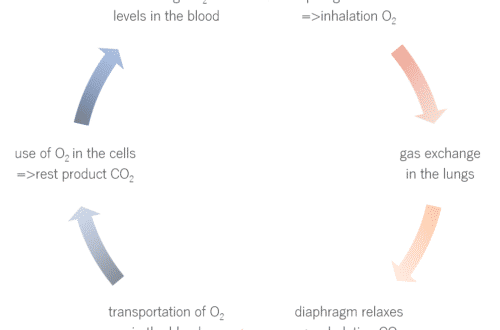Exercises
Learn how to hold your breath longer – Part 2: The Breath
When we breathe normally, we do not use our entire lung volume and many of us have a tendency to breathe in the upper part of the lungs and not “breathing with the belly”. Today I want us to concentrate a little more on the breath and our breathing. You find a video tutorial below.
Breathe consciously
The respiratory system is something that for most of us just works. It regulates itself, among other things, with the help of CO2 levels in the blood which I wrote about in the first part of this series Part 1: Knowledge. However, we breath without needing to think of it. Before a breath hold though, conscious breathing is crucial.

“In this exercise we learn to be more conscious about our breathing”. Nicole Edensbo Freediver in the archipelago of Gothenburg. Photo by: Elin Larsgren The breath
In this exercise we learn to be more conscious about our breathing, finding the volume of the lungs and get used to breathing with “all parts of the lungs” from the belly to the throat. Before a longer breath hold it is good to use as much of your lung volume as possible. If you know you are one of those that tend to breathe very shallow (mainly with the upper part of your lungs), this exercise is good to find the belly breathing. Now, remember we should breathe with the belly, so let it be big and bulge.

Learn how to hold your breath longer, exercise. EXERCISE
Part 2: The Breath
- Find a place where you can lie down comfortably and undisturbed. Lie down straight and relax your whole body.
- Put one hand on your belly and one over your chest and just feel your breathing. Reflect on how your body moves as your breathe.
- Put both hands on your belly and breathe “only with your belly” (very deep) for ten breaths.
(from 00:05 in the movie below) - Put your hands on your chest and breathe “only with your lungs” for ten breaths.
(from 00:35 in the movie below) - Put one hand on your throat and breathe “only with your throat” (very shallow) for ten breaths.
(from 1:05 in the movie below) - Now put your bellybreathing and lungbreathing together. Start by “filling the belly” with air, then fill the lungs. Exhale by first emptying the air in the lungs and then the belly. Blow out all the air when you exhale. Do this for ten breaths.
(from 1:25 in the video below) - Now add all three parts together. Belly, lungs and throat. Start by filling the belly with air. When it is full, you fill the lungs and when they are full you finish your inhale by filling your throat. Exhale by first emptying the air in the throat, then the lungs and finally the belly. Blow out all the air when you exhale. Do this in ten breaths.
(from 2:20 in the movie below)
- In the video below, I do each part three times instead of ten.
- Personally, in the beginning, I found it difficult to find the belly breathing. Therefor, I just tried to breathe and make sure to actively move my belly instead of the chest. Then, after a while, the belly breathing came naturally.
- The exercise above can also be done sitting. Perfect as a little break at work before lunch.
- My advice is to do breathing exercises on an empty stomach or a few hours after eating.
How to hold your breath longer, tutorial video, belly breathing. GOOD LUCK!
Get used to belly breathing
Do this exercise to remind yourself to relax and find your belly breathing. I advice you to do this kind of conscious breathing for some minutes before a breath hold. Before a breath hold I usually breathe deep into my belly and a bit up into the lungs, like step 6 in the exercise. In the last breath before I hold my breath I breathe down into the belly, up into the lungs and then the throat to get in as much air as possible, like step 7 in this exercise.
Be kind to your self, be kind to others.
Nicole Edensbo, 2020-04-24
Gothenburg, SwedenHow to hold your breath longer – Part 1: Knowledge
I have noticed that people are curious about freediving and that there is a particular interest in breathing and breath hold. Very often the I get the question of how long I can hold my breath. Let’s start with revealing that my personal best in STA (static apnea = breathhold in water) currently is 07:05 minutes.
Basic exercises
Most likely, there are as many strategies as there are apneists to improve the breath hold. In this series I will share some exercises along with techniques for breathing, relaxation and stretching to improve the time of the breath hold. The excercises are basic and should suit almost every one. And no, you will not need a pool to do the exercises. A bed, couch or a floor will do perfect!
Before we start!
Before you keep on reading this article I want you to start by doing a breath hold, as long as you can. Count the time and write it down to see how much you, with the help of this series, will improve your breath hold.

Nicole Edensbo doing a STA (Static Apnea). Photo by: Jakob Sandberg Knowledge
First of all, we need to know a little bit of what actually regulates our breathing. Some people might think that it is the lack of oxygen (O2) that creates the urge to breath. That is actually not the case. It is the carbon dioxide (CO2) levels that creates the urge hence regulates our breathing. The regulation of breathing can simply be described as follows.
Regulation of breathing
When the CO2 levels becomes high enough in the blood, signals are sent that cause the diaphragm to contract, which creates an underpressure in the lungs and air is drawn in through our mouth and nose. Simply, we take a breath. The air that we breathe in consists, among other gases, of O2 that our body need to function. The O2 is absorbed by the blood that simultaneously releases CO2 that is ventilated out when the diaphragm relaxes, and we exhale. When the cells in the body work, they consume the O2 and one of the residues of the process is the CO2. The CO2 is transported with the blood and out from our body through the lungs. There the circle is closed, and it repeats over and over again.

Schematic diagram of the respiratory system as a part of the series “How to hold your breath longer”. Have you ever tried holding your breath so that you have felt the contractions? Most likely, you can last at least twice as long. As long as you lie on a flat surface, without the risk of falling and you are healthy, it should not be dangerous to hold your breath for a longer time.
EXERCISE
Part 1: Knowledge
- Choose a place where you can lie comfortably and undisturbed
- Settle down and relax
- Take a few deep breaths
- Take in as much air as you can in the last inhalation before your breath hold and then hold
- Start a timer and notice when you get your first contraction
- Hold as long as you can
- Breathe!
- Stop the timer
- Write down the time for the first contraction and the total time of breath hold
- Repeat this four times
- Make sure you recover at least twice as long as you hold your breath
GOOD LUCK!
Benefits from exercise
For many people the contractions comes later the second and third time they do the breath holds in this exercise. For some that means a more comfortable and longer breath hold. If you do this exercise a couple of times a week you’ll get to know yourself and learn how to handle the contractions and the uncomfortable feeling better. Your body will also slowly get used to lower oxygen levels. This means it is the first step to increase the time of your breath hold capacity.

“The CO2 is transported with the blood and out from our body through the lungs.” Be kind to your self, be kind to others.
Nicole Edensbo, 2020-04-15
Gothenburg, Sweden


